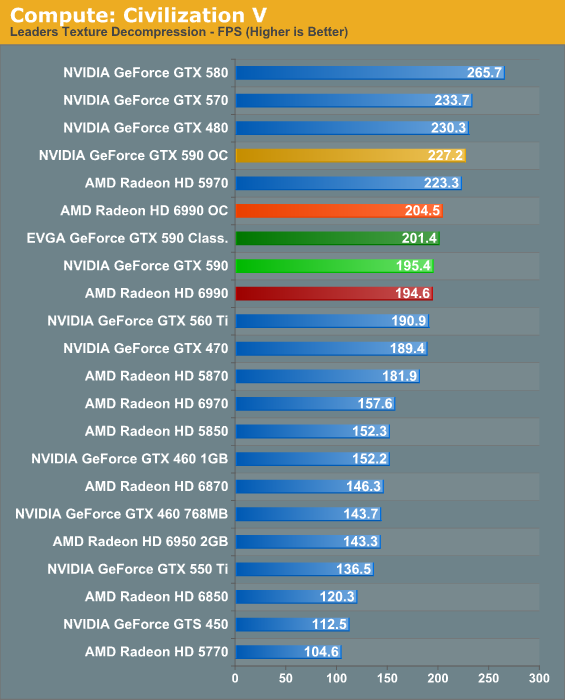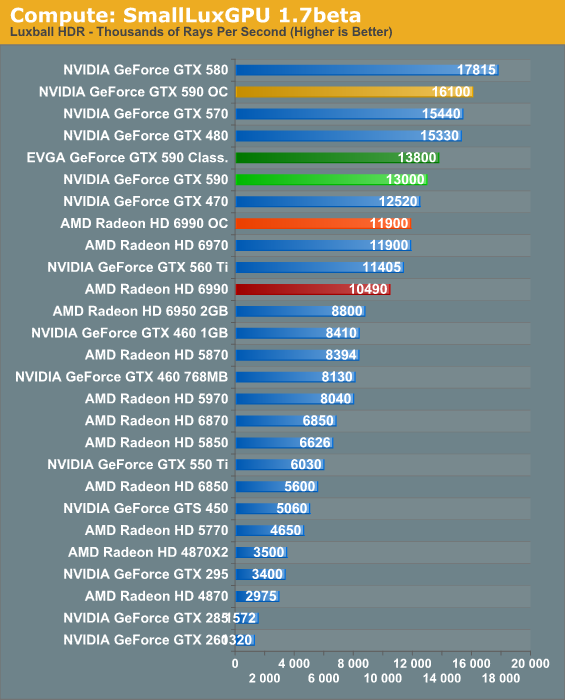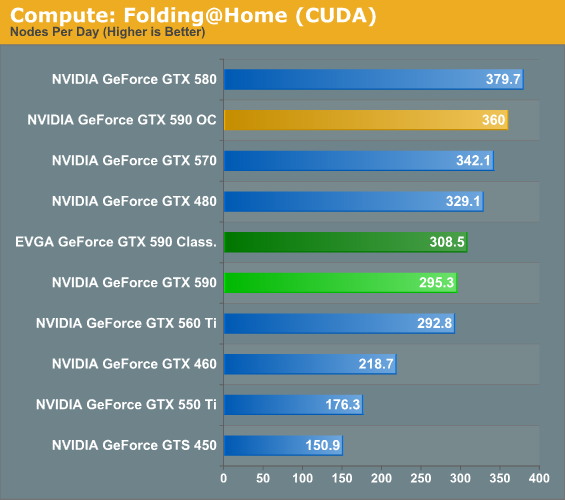NVIDIA’s GeForce GTX 590: Duking It Out For The Single Card King
by Ryan Smith on March 24, 2011 9:00 AM ESTCompute
Moving on from our look at gaming performance, we have our customary look at compute performance.
Our first compute benchmark comes from Civilization V, which uses DirectCompute to decompress textures on the fly. Civ5 includes a sub-benchmark that exclusively tests the speed of their texture decompression algorithm by repeatedly decompressing the textures required for one of the game’s leader scenes.

In the game world Civ5 benefits significantly from SLI and CrossFire. For our texture compression test however AFR is more a liability than a benefit. This doesn’t impact the game in any meaningful manner, but it’s an example of how SLI/CF aren’t always the right tool for the job. Unfortunately for both parties, with as few compute applications as there are today, almost none of them benefit from SLI/CF.
Our second GPU compute benchmark is SmallLuxGPU, the GPU ray tracing branch of the open source LuxRender renderer. While it’s still in beta, SmallLuxGPU recently hit a milestone by implementing a complete ray tracing engine in OpenCL, allowing them to fully offload the process to the GPU. It’s this ray tracing engine we’re testing.

SmallLuxGPU only currently supports ray tracing with one GPU, so all of our results are effectively proxies for what would be if the GTX 590 only had one GPU. Not surprisingly overclocks do wonders here, and NVIDIA’s strong compute architecture gives them an easy win. SLI/CF performance will become more important here when we upgrade to LuxMark for our next iteration of our benchmark suite, as LuxMark can handle multiple OpenCL drivers.
Our final compute benchmark is a Folding @ Home benchmark. Given NVIDIA’s focus on compute for Fermi, cards such as the GTX 590 can be particularly interesting for distributed computing enthusiasts, as two GPUs should be able to quickly retire work units.

Folding@Home doesn’t directly benefit from CF/SLI at all. However by dispatching one WU to each GPU it’s possible to double effective performance. With that taken into account the GTX 590 is quite an effective cruncher, particularly when we start looking at overclocking.










123 Comments
View All Comments
7Enigma - Thursday, March 24, 2011 - link
Yeah I don't get it either. The last review of the 6990 was fantastic with how it was color-coded. Now you have a DIRECT competitor in both price and performance and the 6990 is never highlighted in the charts!?!? It made it a real PITA to always go hunting for the 6990 bars when they should have been labeled from the get-go.Hopefully this can be remedied easily...
rabidsquirrel - Thursday, March 24, 2011 - link
Red/Green is horrible for those of us in this world that are colorblind. Blue/Green is equally horrible. I'd like to see textures used instead.JarredWalton - Thursday, March 24, 2011 - link
I've changed Ryan's colors. Green is for the stock and EVGA clocks, yellow is for OC 590, red for 6990, and orange for 6990 OC. For the color blind, I apologize but using green/red for the primary cards is pretty standard.rabidsquirrel - Thursday, March 24, 2011 - link
Common colorblindess is between Green/Red and Green/Blue. Red/Blue works great!Dudler - Thursday, March 24, 2011 - link
"After talking to several other reviewers, this does not seem to be an isolated case, and many of them have killed their cards with similar testing, which is far from being an extreme test.""I most strongly advise anyone to stay away from overclocking this product and use extremely conservative settings, maybe up to 650 MHz and no voltage adjustments."
Looks like it is no OC champ.
For high res action, H got their review up. 6990 even beats the 590 at Civ V. Conclusion is damning too:
"We truly thought the GTX 590 was going to make the Radeon 6990 look bad, but the fact of the matter is that NVIDIA made the 6990 look that much better. The GTX 590 is not the "World's Fastest Single Card Solution" as stated on our page 1 slides; the Radeon HD 6990 is very much retaining that title. Hail to the King, baby! "
2x 6950 on water looks to be my next buy. Must buy wider desk though :-)
Dudler - Thursday, March 24, 2011 - link
http://www.youtube.com/watch?v=sRo-1VFMcbc&fea...SweClockers also fried their card.. The blame nVidia quality drivers.
Nfarce - Thursday, March 24, 2011 - link
Fanboy much? Anyone who is an AMD/ATi fanboy shouldn't be crowing about nVidia driver quality. That's one reason I left AMD and went full nVidia-only GPUs after a 4870 purchase. nVidia cards also play a lot nicer on Microsoft FSX, but not everyone cares about that just like not everyone cares about Civ5.Dudler - Thursday, March 24, 2011 - link
?? Fanboy? NVidia just released their highest end($700) card with a driver that fries it if you overvolt. Me commenting on that, how come that is fanboyism?It is nothing short of a disaster. Sweclockers fried 2(two) Gtx590's. Thats $1400 worth of hardware. TPU fried one.
Sure I've had my share of driver issues with ATi, but not any more than with my 8800Gt. Couldn't care less whose name is printed on the sticker.
cmdrdredd - Thursday, March 24, 2011 - link
"fries it if you overvolt."_______________
YOU overvolted it...not the drivers doing it automatically. Remember the saying "your mileage may vary" or "proceed at your own risk"?
Dudler - Thursday, March 24, 2011 - link
Yup. But who doesn't expect voltage tuning today? Read the back of the ASUS box: "50% faster with voltage tuning." Nice way to say: This card can't be oc'ed. It will catch fire. But of course, you are overvolting so it is your own fault.But, only reason I posted it was to warn ppl who invest $700 in a card and has it fry on them. I'm not arguing who shall take blame.
Be careful, at least 6 cards dead, stay away from oc'ing it.